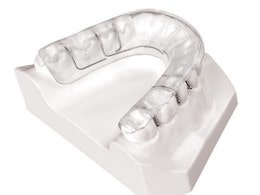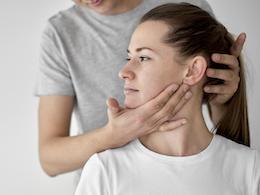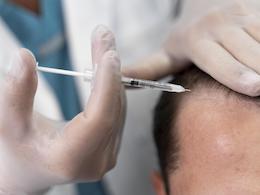With a diagnosis in hand, treatment can begin. Just as each individual is different, so is the treatment. Depending on your symptoms, a proper treatment plan will be created to meet your individual needs. Typically, you may undergo several treatments to help alleviate the pain symptoms associated with your condition.
A comprehensive treatment plan might include the following options:

Orthotics/splints:
Oral splints may be recommended to manage the impact of clenching or grinding forces, which could be contributing to your symptoms. This treatment option is available at our office, offering a targeted approach to address and alleviate related issues.

Spray and Stretch:
With the use of a very cold spray, the muscle is temporarily distracted, which allows a doctor or therapist to stretch the muscle to the point of release. Once a trigger point is released, the muscle is moved throughout its full range of motion. A patient must continue to perform limbering, stretching and strengthening motions outside of physical therapy sessions to retrain the affected muscle.

Medications:
Temporary pain relief is a critical part of the treatment strategy, as it helps a myofascial pain sufferer cope with the ongoing pain of the condition. Over-the-counter NSAIDs, such as ibuprofen and naproxen can help a patient manage the pain. Tricyclic antidepressants have also been found to help relieve pain.

Physical therapy:
Contraction of the muscle due to a taut band and muscle trigger point may be relieved with physical manipulation by a trained professional. Massage movements in long strokes along affected muscles and stretching exercises may help to relieve muscle tension. If poor posture is contributing to muscle fatigue and tension, a physical therapist may conduct and recommend exercises aimed at improving posture over the long term.

Trigger Point Pressure Release:
Trigger Point Pressure Release is a therapeutic technique that entails the gradual application of increasing pressure on a muscle trigger point. This method is designed to effectively soften the tense muscle tissue associated with the trigger point and the taut band, providing relief and promoting relaxation.

Trigger point injections:
In this treatment, a local anesthetic, such as lidocaine or corticosteriod medication, is injected into the tender knotty tissue of the muscle trigger point. The injection works to relax the tension of the trigger point and relieve associated pain, allowing the trigger point to be released and more effectively addressed with physical therapy. (Refered if indicated by Physiatrist)
Treatment of myofascial pain is often dependent on the patient’s level of health or severity of the injury. Additionally, an individual’s rate of improvement may also vary based on a number of conditions such as:
Treatment is important in providing relief from myofascial pain. Contact Craniofacial Pain & Dental Sleep Center of Georgia for more information.

